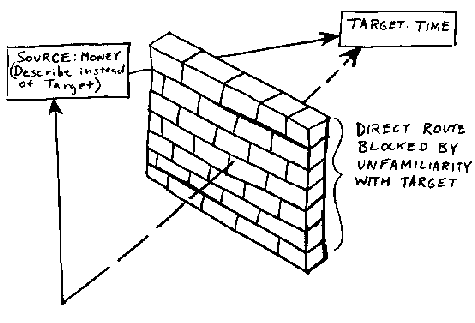Return to MODULE PAGE
Metaphors & Familiarization
Clay Beckner: Author
Metaphors help us to understand new or complex situations, by describing such experiences in terms of things that are more familiar to us. In some cases, familiarization through metaphor takes the form of "word extension": we don't yet have a word for a thing, so we make use of words describing something else that resembles the thing in some way. This phenomenon is particularly observable in cases where the speaker has a limited vocabulary. For instance, Eva Kittay describes a two-year old child who has an earache, yet who does not yet know the word for "earache": He "comes into his mother's room, holding his ear and crying. He says, 'Mummy, an elephant stepped on my ear.'" Similarly, the pioneering sign-language researcher Abbe Sicard tells the story of Massieu, who was born deaf and was not exposed to sign until the age of fourteen. Sicard only taught Massieu nouns at first, which caused his student to extend his limited vocabulary through metaphor: "Massieu did not wait for the adjectives, but made use of names of objects in which he found the salient quality he wanted to affirm of another object. . . To express the swiftness of one of his comrades in a race, he said 'Albert is bird'; to express strength he said, 'Paul is lion'; for gentleness, he said, 'Deslyons is lamb.'"

Yet at times, familiarizing metaphors seem to be more complex than mere word extension; it might be said that they represent not just "figures of speech," but "figures of thought." Direct understanding of a thing is not always limited by its novelty; in some cases, the thing we wish to describe is simply to intangible, abstract, or complex to ever be perceived directly. In such cases, it might be said that our understanding of the target entity is entirely metaphorical. We must often understand (not just describe) inaccessible things in terms of what is accessible to us. As one example, consider the pervasiveness of the metaphor "Time is money" in English:
- You're wasting my time.
- This gadget will save you hours.
- I don't have the time to give you.
- That flat tire cost me an hour.
- I've invested a lot of time in her.
- I don't have enough time to spare for that.
- You're running out of time.
- You need to budget your time.
- Put aside some time for ping-pong.
- Is that worth your while?
- Do you have much time left?
- He's living on borrowed time.
- You don't use your time profitably.
- I lost a lot of time when I got sick.
- Thank you for your time.
It seems that our understanding of something abstract like time depends entirely on likening it to tangible or visible entities--money, a line, an arrow, a spatial dimension, a field, etc. Thus for a computer to understand what time is, it would perhaps need to do what humans are able to do: make use of metaphor as an indirect cognitive device.
Defamiliarizing metaphors provide an aesthetic complement to the cognitive resource provided by familiarizing metaphors. Both types of metaphors are addressed through simulation by ProtoThinker.




